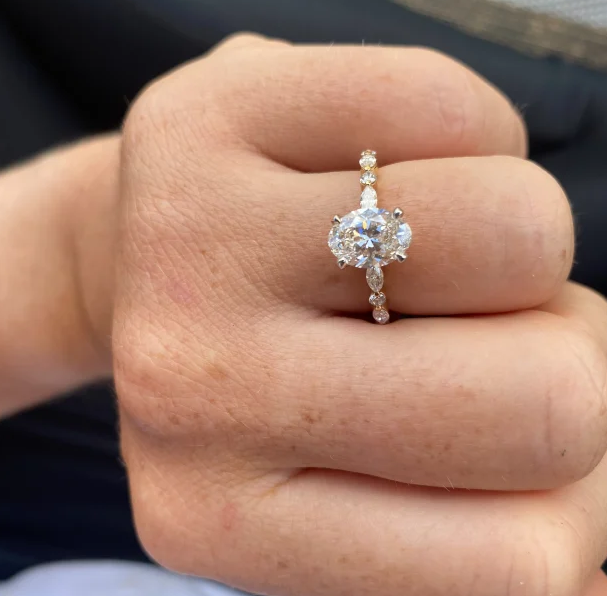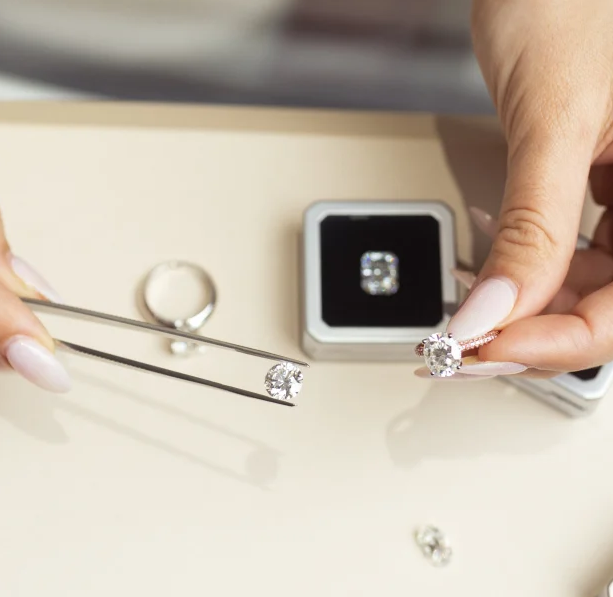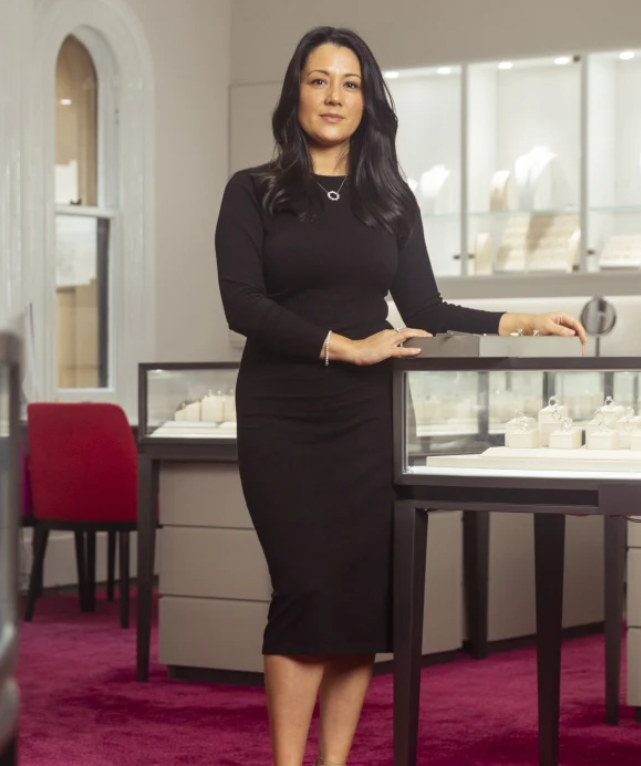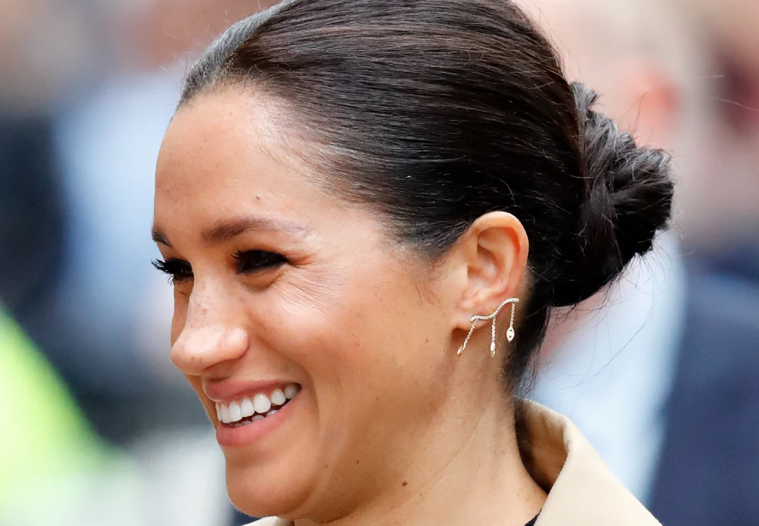Alexis Clarke’s strawberry-blonde hair is pulled back from her face, and she’s wearing no-nonsense black leggings, black running shoes and an olive-green puffer jacket on this chilly day in Thirroul, a northern suburb of the NSW coastal city of Wollongong. Glowing slightly, she looks as though she’s just arrived from the gym (and in fact she has).
But we’re not meeting in this ordinary café to talk about gyms or fitness, or to moan about the damp chilly weather or even to talk about the highlights of the one-time coal-mining village of Thirroul. We’re here to talk about diamonds, those brilliant multi-faceted cut gems that have started wars, stoked conflict, graced the heads of royalty (both Hollywood and actual) and sparkled from millions of ring fingers around the world.
On Clarke’s hand shines a ring that both tells the world she’s engaged to be married and serves as a symbol of a global upheaval in the multi-billion dollar diamond industry. Her engagement ring is a thing of delicate beauty and twinkles when she moves her hand. The central diamond is flanked by smaller diamonds on a band of 18 carat gold. So far, so traditional. But these diamonds were created by technicians in a controlled environment rather than dug out of the ground. It’s a diamond revolution that has divided the industry; with warring factions on both sides.
Clarke, 38, adores her thoroughly modern ring. She designed it herself and it turned out exactly as she hoped. She holds her hand out and smiles: “I love it. And it’s forever.”
Chemically and physically identical to mined stones, the so-called ‘lab-grown’ diamonds in her ring are often generically described as ‘factory-grown’ and ‘synthetic’ by critics who shudder at the incoming tide of man-made gems. Yet even experts need specialist equipment to tell the difference between the two types of diamond; to know whether a stone has been matured for billions of years in the earth’s mantle or produced in a matter of weeks or days in a lab or factory.
Traditionalists point out these man-made diamonds are rapidly losing value as manufacturing techniques are refined and production accelerated. They say the manufactured stones are environmentally suspect, because creating diamonds in a lab requires immense amounts of energy (although it has yet to be finally determined whether more energy, in total, is needed to make a lab-grown diamond than to pull a diamond out of the earth). On the plus side for consumers, the lab-grown stones are considerably cheaper than mined stones: there’s simply a lot more bling for the buck. Many buyers are voting with their wallets – twice or three times the size for the same price? Yes please.
Originally from New Zealand, Clarke has lived with her Australian partner, Trent Akhurst, for ten years; they own a house together ten minutes from central Thirroul and they have a five-year-old daughter. As a family, they have just spent a year travelling around Australia in a caravan. Akhurst, 46, works in a nearby coalmine, and together the couple owns and runs an online company, At Health Australia, which provides organic protein powders and collagen supplements to health food shops and the like.
Last year Akhurst said he wanted to cement their commitment to a life together. He wanted Clarke to design the ring, and then he would choose a time and place and formally ask her to marry him.
“He actually brought it up, saying I think it’s time, but can you choose the ring, and once I’ve got the ring, I’ll propose, in my own time,” she says with a smile. “I found it overwhelming, choosing the ring for myself, I don’t know how guys choose. It’s such a huge decision and choice.”
Sipping an almond chai latte in the Thirroul cafe, Clarke says she had an idea of what she wanted her ring to look like, but it took her a long time to get started. Travelling through remote Australia with a caravan was not conducive to finding high-end jewellery, and the pandemic lockdowns meant she couldn’t go into shops and try on engagement rings for size and shape. She finally found the design she wanted on Instagram, took a screenshot and filed the image away.
A little later, listening to a business-oriented podcast that she often tunes into, she was struck by the ideas of jeweller Lauren Chang Sommer, co-owner of the Sydney-based lab-grown diamond specialist jeweller Moi Moi Fine Jewellery.
“I was immediately drawn to it,” Clarke says. “Just in terms of knowing where your diamonds come from, she also spoke about them being more ethical for the planet. And I’d always wanted quite a big diamond. How often do you make a purchase like this? It’s a once-in-lifetime purchase. So you want it to be really special. And I didn’t want the price to limit my options.”
Clarke had been wearing her grandmother’s classic engagement ring, set with a beautiful old garnet and she loved it. But Akhurst wanted her to have a ring that he could give to her, and she wanted a diamond. “I was open to other gemstones, but for me it really comes down to a diamond lasting forever; everything a diamond symbolises in terms of weddings. It just felt right to have a diamond.”
Her collaboration on the ring design was conducted entirely on-line. She sent the screenshot image to Moi Moi and in return received detailed computer drawings and eventually a render. The couple’s budget bounced up a little, but with a house and a child they were pragmatic, she says, and the final price was a little under $10,000.
Advised by Moi Moi, she eventually settled on an oval-cut 1.67 carat white centre diamond flanked by an alternating combination of four small marquise-cut diamonds and four small round-cut diamonds – adding up to a total of two carats. The central diamond came with a third-party grading report confirming the stone’s colour, clarity, carat, weight and cut.
To begin with, Clarke took her ring off for safekeeping when she went surfing, but she is now sure it fits well and it won’t come off, so it stays on her finger all the time.
“It’s exactly how I wanted it. If I had not gone with a lab-grown diamond I would have had to sacrifice some size there, I think, which would be a shame,” she says.
She doesn’t care if the diamonds were made by technicians. “We’ve ripped it out of the earth in these dirty environments; there’s nothing glamorous about the mining industry.”
She picked the ring up in January, and later that month, when the family were holidaying at a favourite camping and surf spot in Crescent Head, in northern NSW, Akhurst went down on a knee and asked her to marry him. Their daughter looked on. “It was magic,” Clarke says. The wedding will be sometime in summer next year.
Technicians from the US firm General Electric made the first lab-grown diamonds in 1954, using high pressure and extreme heat to replicate the conditions of the earth’s mantle, but it took decades to refine the techniques and produce larger and cost-effective gem-quality stones.
The original HPHT (high pressure high temperature) way of creating lab-grown diamonds uses a large mechanical press to simulate the conditions that prevail deep underground. Extreme pressure and high temperatures are applied to a diamond seed which becomes a kind of template for carbon to grow in a lattice, layer by layer over a short period of time. This HPHT method has now largely been replaced by CVD, chemical vapour deposition) – the seed is put in a plasma reactor chamber and a mix of gases containing carbon is added at very low pressure. Microwave energy heats the gases and creates a plasma and when temperatures are pushed up the gas molecules break up and carbon atoms bond to the seeds, which slowly grow, again layer by layer.
Both methods use enormous amounts of energy, and the champions of mined (or natural) diamonds note that by far the most lab-grown diamonds are produced in China, followed by India and neither nation is known for promoting high environmental and labour standards. According to a report published in February on the state-owned China Daily media website, China produces about half the world’s lab-grown diamonds, mostly in Henan province, in central China, where the small city of Zhecheng has become known as the nation’s diamond capital, and where billions of yuan (or hundreds of millions of dollars) have been invested in diamond-producing factories.
On the second floor of Sydney’s palatial Queen Victoria Building, Lauren Chang Sommer gazes over the extensive Moi Moi jewellery store she founded with her sister, surveying the high arched windows, the lush cerise carpet and the wide range of lab-grown jewellery on display: rings, earrings, bracelets and necklaces shimmering in their glass cases. Wearing a conservative black suit and intensely pink high heels that match the store’s shocking pink sofa, she is, of course, sparkling with diamonds – in her ears, on her hands, around her neck.
She and her sister, both Sydney born and bred – the children of an Australian mother and a Chinese-Malaysian father – first set up shop in 2004, selling moissanite, another type of lab-grown jewel. The name Moi Moi was inspired by moissanite, but it also means little sister in Cantonese, a language spoken by their father.
Moi Moi launched into lab-grown diamonds as a natural follow-on from moissanite, becoming one of the first Australian jewellery companies to be fully invested in the man-made diamonds – both the HPHT and CVD stones. “It’s an entirely new concept, an entirely new category for the jewellery industry,” Sommer says.
Importantly for many buyers, she adds, the provenance of most lab-grown diamonds is traceable. Many lab-grown diamonds have a tiny identifying individual laser inscription, invisible to the naked eye. Still, Moi Moi sources stones from a trader, and Sommer says she doesn’t always know where the diamonds were made. “You can tell but not always. These things will become more defined as we evolve as an industry.”
A growing number of modern buyers want to ensure the diamonds they choose are not tainted by association with violent warlords, or organised crime, or exploited labour, or third world environmental carnage. They want to know how sustainable the diamonds mines are, how many tons of rock and dirt have to be shifted per carat of mined diamond extracted from the earth. They can also raise an eyebrow at lab-diamonds, especially if the provenance is unclear.
Last year, Pandora, the Danish company that makes much of the world’s high street jewellery, announced it would henceforth use only lab-grown diamonds (and recycled precious metals) for the sake of global sustainability. The Natural Diamond Council (NDC), the World Jewellery Confederation (CIBJO), the World Diamond Council (WDC) and the Responsible Jewellery Council (RJC) were quick to respond, issuing a joint statement to say the diamond industry employs tens of millions of people around the world and many people in developing nations rely on income, and other benefits, from diamond mining. Pandora’s announcement, the group added, could “have unintended but substantial consequences”. One sceptic adds that since Pandora’s diamond jewellery accounted for as little as 0.2 per cent of the company’s total sales, the campaign was more of a publicity stunt than anything else.
Yet there are real concerns. Last July, toxic waste from Angola’s biggest diamond mine leaked into waterways, killing at least 12 people down-river in the Democratic Republic of Congo. In Sierra Leone, residents of Koidu sued the operators of the Octea diamond mine, claiming in a class action that the operators dumped mine waste and damaged their homes.
The 2006 film Blood Diamond, starring Leonardo di Caprio, told a story of warlords funded by diamond mines during Sierra Leone’s brutal civil war. The film rattled the diamond industry and insiders insist the certification systems now in place, such as the Kimberley Process, have all but eliminated the trade in conflict gems. Yet there are still ethical qualms: in recent years there have been reports of Zimbabweans caught and tortured for trespassing on the nation’s Marange diamond fields.
Many in the jewellery industry, including the luxury brand Tiffany, now refuse to buy diamonds from mines in Zimbabwe or Angola. But the provenance of a substantial proportion of mined diamonds is difficult to track as it twists through dealers and buyers, and diamond mining giant de Beers is working on expanding and refining its blockchain tracing system so stones can be followed from mine to retailer.
A few celebrities are voting for the man-made gems with their ears, wrists, necks and fingers. Meghan Markle has been seen wearing lab-grown diamond earrings and Bindi Irwin, daughter of the famed television personality Steve Irwin, has sported a lab-grown diamond engagement ring.
Moi Moi has been selling these lab-grown jewels for two and a half years now, Sommer says, and demand has surged. In 2018 she went to the Las Vegas launch of Lightbox, the lab-grown diamond range from de Beers – the company that had a near monopoly on the diamond trade until the end of the 20th century. It still accounts for one-third of the world’s diamond supply by value, with mines in Botswana, Namibia, South Africa and Canada.
In the post-WWII baby boomer years, with diamond prices slumping, De Beers focussed on diamond engagement rings with the wildly successful “A Diamond is Forever” campaign, a line which continues to influence buyers today. Ordinary diamonds aren’t particularly rare, but over the decades the jewels have become entwined in myths of luxury and scarcity – and the idea that true love is signalled with a single large rock on a gold band, hauled at great effort from the bowels of the earth and sanctified with gradings and certificates and maybe even the spice of danger.
In 2020, seemingly bowing to the inevitable upsurge in man-made diamonds, the De Beers behemoth opened a factory in Oregon in the US to produce the Lightbox range of lab-grown diamonds. More than 200,000 polished carats can be produced in the factory each year.
De Beers now sells these Lightbox diamonds for as little as US$800 per carat, regardless of the size of the stone. The basic price increases in a linear way – US$800 for a one carat stone, US$1600 for a two carat stone and so on. This is markedly different from mined diamonds which have prices that grow exponentially as stones get bigger, and rarer.
At the De Beers Lightbox launch in the US, Sommer was surprised to see Lightbox marketers working hard to promote the lab-grown gems as lower-tier jewels: stones for younger women or lesser celebrations. These days, the Lightbox website encourages consumers to consider “Gifts for Your Grad” and doesn’t even mention diamond engagement rings. De Beers says lab-grown diamonds are for a different mood. “Our research demonstrates that most consumers see lab-grown diamonds as being ideally suited to fashion jewellery for lighter occasions,” a press office statement emailed to me says, adding that “people overwhelmingly prefer natural diamonds for celebrating the most meaningful moments in their lives”.
Sommer is unconvinced. “It was astonishing to me that the marketing they were trying to portray is that lab-grown diamonds are for sweet 16,” she says, adding the audience at the Lightbox launch was annoyed by the assertion. “They (Lightbox marketers) were saying lab-grown diamonds are prosecco and mined diamonds are French champagne. It just seemed so outdated. It seemed offensive. I think they misread the fact that consumers are educated enough these days to be able to make their own decisions.”
Champagne or not, many buyers simply want big stones. Buyers who could never afford a large mined stone that might retail for tens of thousands of dollars can splash out on a lab-grown diamond. “Millennials and Gen Z today, they want size,” Sommer says. “They want something that looks really good on their social media pages. I’m sorry to say a half-carat stone isn’t going to cut it any more.”
Angela Han, publisher of Jeweller magazine, based in Melbourne, says trade feedback and market data show there is a growing interest in lab-grown diamonds in Australia, yet most purchasers are still buying the mined stones. “Every consumer wants to compare the two up close, so queries are abundant – indeed, it’s a novelty to see them side by side – so these days most retailers have access to sample synthetic stones that they can show customers,” she says, adding that jewellery retailers might be reluctant to hold much lab-grown diamond stock because of its rapid slide in value. “After all, you don’t buy and hold stock that you know will be worth less tomorrow than you paid for it today.”
A report by the US management consulting firm Bain, titled A Brilliant Recovery Shapes Up: The Global Diamond Industry 2021–22, said lab-grown diamonds were continuing to “diverge into a separate, more affordable jewellery category” and steadily fall in price as a result of increasing expertise and refined manufacturing methods.
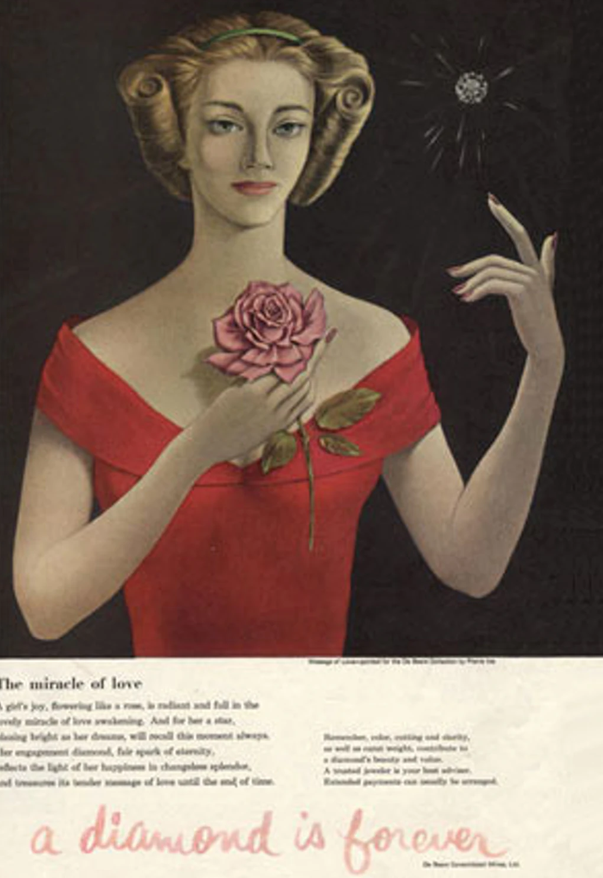 Meanwhile, even the words used to describe the new stones are in dispute. In 2018, CIBJO and eight other industry organisations nutted out guidelines for terminology, after some debate about whether a lab-grown diamond could even be called a diamond at all.
Meanwhile, even the words used to describe the new stones are in dispute. In 2018, CIBJO and eight other industry organisations nutted out guidelines for terminology, after some debate about whether a lab-grown diamond could even be called a diamond at all.
Finally it was decided that a diamond was a “mineral created by nature”; and a “synthetic diamond” or “laboratory-grown diamond” was an “artificial product” with the same physical characteristics as a diamond. Over time, the term lab-grown or lab-created have become widely used descriptors. Bains uses the term lab-grown in its authoritative industry report. The Gemmological Institute of America (GIA), which provides internationally-recognised diamond grading reports, uses ‘laboratory-created diamond’ in its literature. The US Federal Trade Commission refers to ‘laboratory-created’ diamonds. De Beers markets Lightbox lab-grown diamonds.
Suitable adjectives have come in for argument as well. In 2019, the US Federal Trade Commission warned lab-grown diamond suppliers about so-called “deceptive advertising”, noting it was unlikely that descriptors such as “eco-friendly” and “sustainable” could be substantiated. “It is unfair or deceptive to use the word ‘real,’ ‘genuine,’ ‘natural,’ ‘precious,’ ‘semi-precious,’ or similar terms to describe any industry product that is manufactured or produced artificially,” the FTC said. The lab-grown lobby shot back with a request that mined diamonds should be described as “industrially-mined”. The FTC declined the request, noting there was no evidence to determine how consumers might interpret the term.
One up-market Sydney jeweller, who had crossly described the environmental claims of lab-grown diamond manufacturers as “unsubstantiated BS”, was particularly affronted that I used the terms lab-grown and mined to differentiate the two types of stone: he preferred factory-grown and natural diamond. And he was irritated that I failed to specify that diamonds that had come from the earth were billions of years old and probably the oldest thing most people ever touch. He was so annoyed he finally wrote to me to say that he had “withdrawn permission” for me to write about him, his business or his clients.
Garry Holloway has no such hyper-sensitive concerns. Widely regarded as a diamond expert in an industry crowded with experts, he is the owner of the two Holloway Diamonds shops in Melbourne – one in Canterbury and one in Brighton, and the inventor of diamond cut grading tools. He primarily sources diamonds from a cutting and polishing company in India which he says is highly reputable. He prefers to keep its identity commercially in confidence, although he gives me the name, noting he has travelled with the factory CEO by train from the factory, which has a community hospital, and the family dines with the staff in the cafeteria. He says he is happy to leave US$100,000 with the firm on credit, to avoid the need to wait for bank transfers if he needs a diamond urgently, adding “their ethics and value are beyond reproach”. On its website, this cutting company attests that every stone in its inventory comes from “conflict-free mines or trusted, non-conflict sources”.
On another front, Holloway has decided not to stock any lab-grown diamonds at all. His business is bespoke and upmarket, he says, and not a natural fit for gems that are sliding in price. In fact, the words “only natural” have been added to the Holloway Diamonds’ logo.
Yet he says he bears no ill-will toward the newcomer lab-grown gems: in fact he bought a little collection of man-made pink diamonds from one of the first manufacturers of the stones at a gem fair in Tucson, Arizona, many years ago, and he eventually had them made into a ring for his wife. But now he worries that if both types of diamonds were stocked in his shops it could lead to confusion; a customer could be sold a lab-grown in lieu of a mined diamond, and “46 years of reputation would go out the window in one fell swoop”.
Meanwhile, he says, many of the procedures used to cut lab-grown diamonds have already been automated – only the final polishing is still done by hand. He adds that cutting rough lab-grown diamonds in India can cost less than US$100 a carat because the time-consuming planning needed to cut mined diamonds isn’t necessary; there’s no need to work out the best way to avoid the natural imperfections and maximise the return.
Holloway has also done the sums and he says larger lab-grown diamonds cost less per carat to cut and polish than the smaller stones, reducing the cost per carat for larger stones, and he believes that trusted lab-grown diamond manufacturers like de Beers will eventually eliminate the need for third-party grading of lab-grown stones, shrinking the end price even more.
He sees the diamond jewellery market splitting in two. Younger and environmentally-minded consumers will more and more want lab-grown diamonds, he reckons, and the gems will eventually become an upmarket cubic zirconia-type stone widely used in costume jewellery. The resulting upheaval will have profound consequences for the diamond industry as a whole, he says. It will eat into the demand for mined diamonds, eroding the traditional diamond industry at its roots – the mines. “I think lab-grown diamonds are going to take over the world; there will be less and less money for new mines, so natural diamonds will get rarer.”
Holloway Diamonds recently sold a solitaire diamond engagement ring to Stephen Dudley, a banker who lives in Melbourne’s inner suburb or Hawthorn. Dudley, 40, knew he wanted a simple and classic design, but he didn’t know much about the provenance of mined diamonds or even that lab-grown diamonds existed – not that he would have chosen a lab-grown stone anyway. “It was my second marriage,” he says. “The first time I spent a bit more time investigating. This time I just knew I wanted a quality diamond, obviously.” He wasn’t particularly concerned with provenance – which mine the diamond came from – because he trusted the jeweller to sell him a quality, reputable stone and to steer clear of blood diamonds.
He and Nina Rowlands, an interior designer, met on the online dating site Bumble in 2019. She, too, had been married before and it hadn’t been an easy marriage or parting and she was on the defensive. “I was walls-up, but he was there and consistent. It was like a slow burn. He was very patient with me. He knew quite early on that I was his person.”
Within months, Dudley decided to ask Rowlands to marry him. He’s a traditionalist so he wanted to propose with the actual ring, rather than leaving the purchase until afterwards. He chose the ring with the help of an assistant who remembered Rowlands trying on jewellery and remembered which rings she had liked; he would prefer not to disclose how much it cost. “It’s beautiful: simple and classic and timeless,” he says. “Nina has small fingers: it looks beautiful on her finger.”
He picked the ring up from the Canterbury store one Friday in February last year, half an hour before he was due to meet Rowlands at the wine bar where they had first met in person. He was understandably nervous, so the sales assistant gave him a glass of champagne to help him calm down, and he put the ring, in a jewellery box, in his jacket pocket. It bulged a bit and he was concerned it would be noticeable, so he slung it casually over a chair at the very table of the crowded bar where he and Rowlands had sat and chatted the first time they met. The rest, as they say, is history.
“I was completely shocked, I wasn’t expecting it,” Rowlands says, adding that although she and Dudley had spoken about marriage in general terms, they weren’t living together when he proposed. They married in February this year in a small ceremony in Eltham followed by a lunch reception at a winery. The ring shines from Rowlands’ finger in the wedding photos of a joyous couple on the threshold of a life together.
“My first ring with my first husband was very over the top,” she says. “It had a big central diamond surrounded by rings of diamonds, and it didn’t ever really feel like me.” She sold that ring years ago; she didn’t even want it in the house. She loves this new ring: a classic plain gold band with a 1.5 carat round brilliant-cut white solitaire diamond in a simple four-prong setting. “It’s the best colour, and cut and quality,” she says. “Less is more. I always said quality over quantity.”
She hadn’t heard that such a thing as lab-grown diamonds even existed, and even if she had, she says, she wouldn’t have wanted a ring set with one. “No way; I want the real thing.” Dudley later forwarded her diamond’s internationally recognised GIA certificate, which she appreciated. “So I knew exactly what it was, which is important to me.”
Photos by Dominic Lorrimer, Getty.
